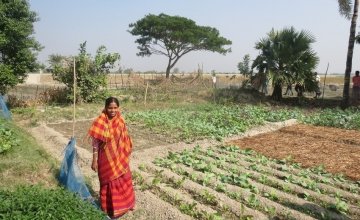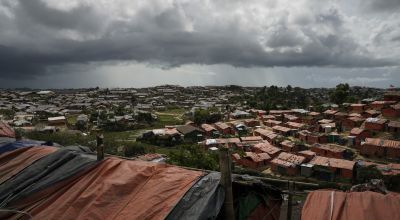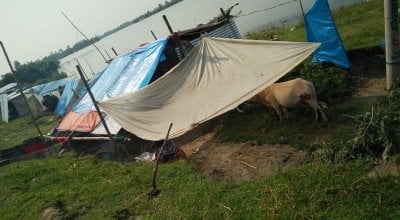
Read our 2024 annual report

Knowledge Hub
Urban disasters: preventing another tragedy in Freetown

In the first of our ‘Thought Leadership’ series, Kai Matturi, Concern’s Programme Knowledge and Learning Adviser, reflects on the devastating impact of climate change and how we can mitigate against it.
Cry Freetown
On 14 August, 2017, the city of Freetown, Sierra Leone, experienced catastrophic flooding, which has been estimated to have killed anywhere from 500 to 1,000 people. Like many people, I became aware of this unfolding disaster through social media. My Twitter account lit up with graphic images of houses and people being washed away.
Once the initial sadness and shock settled, I started to realise that we should put things into perspective. The Freetown disaster is not an act of god or a fluke but rather the culmination of a series of processes.
The science is clear that climate change is having a major impact on coastal flooding. Other contributing factors include deforestation and land encroachment. We should not just blame climate change for the disaster. We should blame society. Society should reflect on the detrimental impact it is inflicting on the environment."
At least 312 people have died after a mudslide caused by heavy rain swept through Sierra Leone's capital, Freetownhttps://t.co/DIjclCOIIw pic.twitter.com/fKNQoxBBE0
— ITV News (@itvnews) August 14, 2017
The impact of climate change
According to the United States National Weather Service’s Climate Prediction Centre, Sierra Leone has received three times its normal seasonal rainfall this year and a rainfall pattern such as this is a direct consequence of climate change.
Data from the United Kingdom Met Office and the United States Aeronautics and Space Administration indicate that the temperature of the earth is rising. Looking at this trend, the vulnerability of coastal cities, such as Freetown, is unprecedented. The sea-level-rise caused by climate change is projected to expose millions of coastal communities to an increased risk of flooding and landslides.
The cost of poverty
The impact of disasters on communities, however, is not just a product of the ferocity of a hazard, but is rather dependent on the resources that communities have to address risk. In Freetown, extreme poverty leaves many residents at the edge of disaster, unable to afford basic shelter, healthcare, and safe food and water. The extreme rainfall was not the sole factor to blame for the mudslides in Freetown. Human encroachment on the creeks and wetlands that act as a natural drainage system for flood water, construction on flood-prone areas, poor waste management leading to blockages in water, and upstream deforestation all cumulatively precipitated this disaster.
Thus, without meaningful and consistent action, disasters like the Freetown floods will continue to occur on a regular basis.

Successful initiatives
The good news is that there is hope. Agencies such as Concern are already implementing practical solutions that seek to combat the ravages of climate change. At a micro level Concern is working with coastal communities to ensure that they can be better prepared for disasters.
Disaster risk reduction in Sierra Leone
In Freetown for example, Concern’s disaster risk reduction work has centred on strengthening and supporting the Community Disaster Management Committees (CDMCs), the local level government structures responsible for disaster risk reduction and emergency response. It helped organize the CDMCs into an umbrella group, Community Disaster Management and Emergency Response Team (CODMERT), a community based organisation that coordinates and provides additional support to individual CDMCs.
The work of CDMCs and CODMERT have focused mainly on awareness raising activities and changing local level behaviours in order to reduce risk. They use a participatory approach to assess the risk context and as a means of engaging residents in behavioural change. They run campaigns focused on safe practices, including those to help reduce the risks of fire, flood, cholera, landslides, and some of the other major hazards within Freetown. They also respond to emergencies when they arise, such as the 2012 cholera outbreak, the 2014 Ebola outbreak and the current landslides.
Building resilience for coastal communities in Bangladesh
Another Concern initiative aimed at supporting coastal communities is the Paribartan project implemented in Bangladesh. The project works with communities along the coasts of the Bay of Bengal to increase their resilience to the effects of climate change and coastal flooding. In collaboration with local communities, a number of successful models that address climate change have been implemented. They include the following: a composite agriculture model, a rain-water harvesting model, homestead gardening, poly-bed cultivation and energy-efficient stoves.

The project has also revealed that local communities have numerous strategies to mitigate coastal risk. They often modify their livelihoods to take advantage of coastal resources, use natural and social structures to recover from disasters, and construct shelters that are resistant to coastal hazards and are easy to repair. For example, they construct buildings on stilts or raised platforms to reduce exposure to storm surges; and they plant crops in accordance with the ever changing growing seasons. The project also builds vital economic assets that reduce poverty and give project participants the tools to invest in short term measures to reduce immediate risks (such as stockpiles during emergencies or more hazard resistant buildings) and longer term measures to address its underlying causes (such as money to invest in education and improved health). This illustrates the importance of an integrated, whole of society approach to combating disasters.
Going forward
Sierra Leone and other at-risk countries can benefit from the above strategies that combine behaviour change and the restoration of degraded ecosystems to buffer against the compounding effects of climate change and the allocation of sustainable alternative livelihood activities away from risk prone areas. Such strategies will prevent possible future encroachment into environmentally fragile zones, thus preventing the degradation of natural ecosystems that offer the best chance against mounting climate change driven disasters.
Concern’s disaster risk reduction work has shown that the best approaches to combating disasters in coastal areas are ones that combine preparedness, natural resource management, livelihoods improvements, water resource management and structural measures. These interventions involve disparate stakeholders at multiple levels. Because disaster risks are the product of many different processes, many of which are the product of underlying factors, reducing disaster risk is a long term project which requires substantial and sustained investment.

Society’s responsibility
Ultimately, I believe that preventing another tragedy from afflicting the residents of Freetown will require a whole of society approach. Writing recently about Hurricane Harvey which has battered Houston, in the United States of America, Ilan Kelman makes the point that blaming climate change, or even just the weather, for the hurricane disaster distracts from individuals’ and society’s responsibility for where we live, how we live and how we support people who cannot help themselves. He goes on to make the point that this vulnerability, not nature and not climate change, causes disasters. I would add that a similar narrative could be applied to the landslide and flooding that brought untold damage to Freetonians.
About the author
A native of Bo, Sierra Leone, Kai Matturi works with Concern Worldwide as their Programme Knowledge and Learning Adviser. The views expressed in this article are those of the author and do not necessarily represent those of Concern Worldwide or any of its partners.
Learn more about Concern
Learn more about the diversity of our work in 26 countries worldwide
In depth





